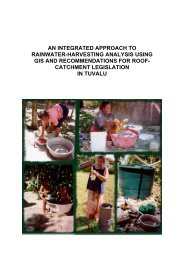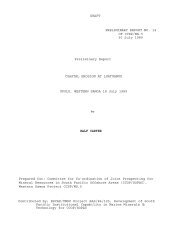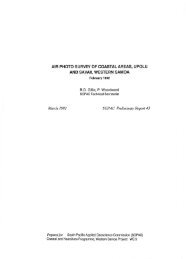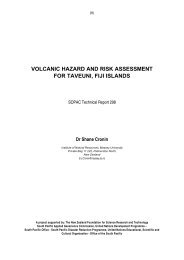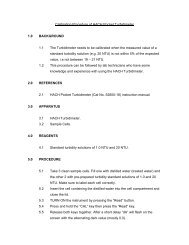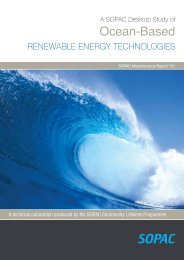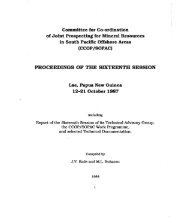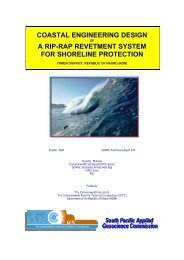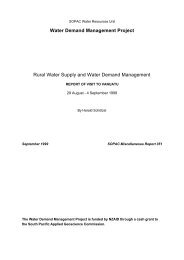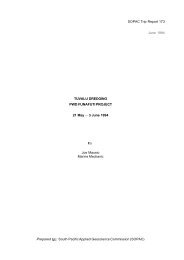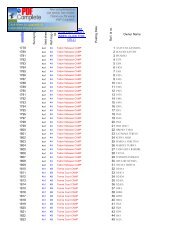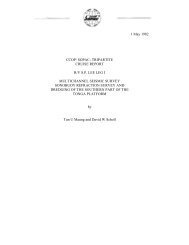Trip report regarding remote sensing activities at ... - Up To - SOPAC
Trip report regarding remote sensing activities at ... - Up To - SOPAC
Trip report regarding remote sensing activities at ... - Up To - SOPAC
You also want an ePaper? Increase the reach of your titles
YUMPU automatically turns print PDFs into web optimized ePapers that Google loves.
4.3 Zoning of the image<br />
While processing the image, it appeared th<strong>at</strong> 4 different<br />
zones can be defined off it :<br />
- the reef area,<br />
- the closed lagoon area covering the submerged<br />
delta,<br />
- the mangrove area,<br />
- the land area.<br />
These zones of geological interest are much different, they<br />
will be processed separ<strong>at</strong>ely. <strong>To</strong> separ<strong>at</strong>e the zones, we<br />
graphically contour them in interactive mode, using the forth<br />
IVAS channel. Then, a mask is cre<strong>at</strong>ed overlaying each zone,<br />
from which the areas are calcul<strong>at</strong>ed.<br />
5. Processing of the rectified and zoned image<br />
Each zone is processed separ<strong>at</strong>ely because of its<br />
reflectance and of its distinct geologic interest.<br />
5.1 Calcul<strong>at</strong>ion of the transfer function<br />
The choice of the m<strong>at</strong>hem<strong>at</strong>ical function depends upon the type<br />
of inform<strong>at</strong>ion we want to come up with. Therefore, we used the<br />
following functions for processing the SPOT image of the Ba<br />
River area :<br />
- a linear upgrading function applied to areas,<br />
in between limits or not, of the chosen zone;<br />
- an exponential function applied inside the limits of<br />
the histogramme peak, to upgrade preferentially the<br />
high pixel luminance classes in the lagoon zone;<br />
- a function of distribution of the pixel classes<br />
(function of their luminance), which re-divides the<br />
pixels in classes of equivalent number, called<br />
equipopul<strong>at</strong>ion distribution.<br />
More complex functions are also employed to determine<br />
different r<strong>at</strong>ings (see appendix II). The following r<strong>at</strong>ings are<br />
used to process the different zones.<br />
- chrom<strong>at</strong>ic r<strong>at</strong>ing (Ref. 4), which is use to show the<br />
turbidity of the w<strong>at</strong>er and the shallow lagoon bottom; -<br />
veget<strong>at</strong>ion r<strong>at</strong>ing (Ref. 5), for the mangrove zone;<br />
- soil shining r<strong>at</strong>ing (Ref. 5), to differenti<strong>at</strong>e bare soils<br />
in the land and wetland zones.<br />
4




